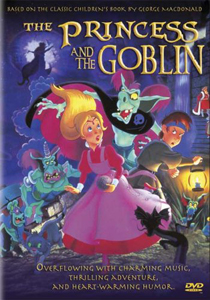Unfortunately for “The Princess and the Goblin” (1991), it was released in the United States in 1994, the same year as “The Lion King.” Comparisons are inevitable and mostly unfavorable. But on a deeper level, the lesser-known movie bests the blockbuster.
Where “The Lion King” is impressive, dynamic and slick, “The Princess and the Goblin” is clunky, cumbrous and even a bit sad. According to IMDB estimates, “The Princess and the Goblin” lost $8 million while “The Lion King” netted $900 million. The animation of the former is inferior and its French horn-heavy melodies are indifferent. None of its musical numbers can hold a candle in the wind to “Can You Feel the Love Tonight.”
Perhaps the film’s bifurcated production origins (in both Wales and Hungary) led to its disjointedness. It does feel like it ought to have gone straight to VHS. (Today, its out-of-print DVD is scarce, though it does turn up on YouTube.)

“The Princess and the Goblin” (1991)
Director: József Gémes
Writer: Robin Lyons (based on a story by George MacDonald)
Stars: Claire Bloom, Joss Ackland, Roy Kinnear
Its richly atmospheric backgrounds utilize mist and smeary watercolors to create intimidating underground vistas, and its characters are attractively drawn and shaded, but often jumpy and unnatural in their movements. The sound engineering feels second-rate. The film wants for cohesion in its elements.
Still, there is more to “The Princess and the Goblin” than its falling short of Disney levels of polish and profit. It deftly captures the childlike wonder upon being confronted with the supernatural.
The 1872 George MacDonald source material
Scottish Congregational minister and poet George MacDonald may be at once the most influential and least-read children’s author of all time. C.S. Lewis made MacDonald a stand-in for Virgil in Lewis’ reworking of “The Divine Comedy.”
G.K. Chesterton wryly asserted that the book on which this film was based was, compared with every story he had ever read, “the most real, the most realistic, in the exact sense of the phrase the most like life.” Without MacDonald, it is hard to imagine J.R.R. Tolkien. Or J.M. Barrie. Or Lewis Carroll, whom MacDonald mentored.
The Rev. MacDonald claimed not to write for children, but for the childlike – and I’m sure he meant that in a good way. In the first four charming paragraphs of “The Princess and the Goblin,” he introduces Princess Irene “with eyes like two bits of night sky, each with a star dissolved in the blue.”
Beneath the castle lies a shadowy subterranean world – mines worked by men but inhabited by goblins. The goblins’ origin is likewise shadowy, but apparently, generations prior, they retreated underground to avoid excessive taxation by the king. And though misshapen, they are clever and mischievous. Their only weaknesses are a well-sung tune and their overly sensitive feet.
The film renames the novel’s plucky, well-mannered heroine (age 8) Ireney for some reason. But in most respects, the film follows the source material closely. It introduces a bit more light romance between the princess and the miner’s son (Curdie, age 12) who, as MacDonald described him, bore “eyes as dark as the mines in which he worked and as sparkling as the crystals in their rocks.” Together, the two will go toe to toe with the goblin hordes.

A charming tale
I challenge any parents to take the Simba versus Irene challenge with their youngsters: Play “The Lion King” one afternoon and “The Princess and the Goblin” on another and see which of the two gets replay requests.
The only caveat is that the goblins are a wee bit PG-13. They pick their noses and fling their boogers. They threaten to kill the young protagonists, and they mean business. They even kidnap the princess so she can be forced to marry a goblin, which gets perilously close to suggesting Irene is in danger of being raped by a monster.
The goblins are a bit comical, but they’re also grotesque and frightening. Ralph Steadman might have drawn them. If anything, they might be too scary for younger viewers. But the goblins’ dangerousness is held in check (for the most part) by the family structure of Curdie’s and Ireney’s fathers.
Ireney’s father, the king, gives the family-framed goblin-squabble additional solidity. I couldn’t decide if he was more a cross between Jason Kelce and King Lear – or between Travis Kelce and the plastic-faced Burger King mascot. In either case, he has some real pathos. After returning from a lengthy absence, he promises Irene he’ll spend more time at home. Children will probably find his voice genuine, but an adult can hear an implicit doubt about whether he’ll be able to keep his promise.
The real brilliance of this flawed film is in the deeply meaningful conflict Ireney and Curdy find themselves in. The layering of magic, symbolism and the supernatural give a sparkle and also an apprehensiveness to the narrative. There’s genuine tension in “The Princess and the Goblin.” The idea of goblins plotting in caverns beneath a castle is unsettling. And the only way to fight goblins is with wit, song, courage and tenacity. Also, stomping on their feet proves itself an excellent technique.

